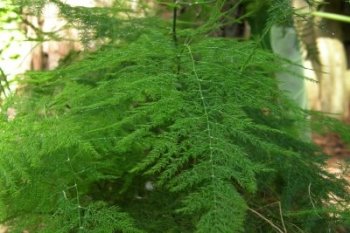
ASPARAGUS FERN: MPI REJECTS APPLICATION
In the September Newsletter it was reported that I have applied to the MPI for permission, under Sections 52 and 53 of the Biosecurity Act 1993, to grow Asparagus plumosus (asparagus fern) for the purpose of selling the stems to the cut-flower industry. As I discovered last year, such permission is required since Asparagus plumosus has been declared an Unwanted Organism, and so there is a ban on the sale of any part of the plant which could serve for its propagation. In his application I argued that, since the plant cannot be propagated from the stems, they pose no environmental risk, and that adequate controls could be put in place to ensure that plants grown for their stems would not be released into an environment where they would be invasive.
On 16 October the MPI informed me that the application has been declined. This decision is disappointing, especially for the many florists who signed a petition supporting the application. Some of their comments suggest that Asparagus fern stems will continue to be traded, albeit illegally – though not by us, of course, since our business will undoubtedly be closely watched by the local biosecurity inspectorate.
Although disappointing, the decision was not unexpected. I had been advised that the application was likely to be rejected on the grounds that even if, as I argued, the sale of Asparagus fern stems would present no direct biosecurity risk, it would cause indirect biosecurity risks by "promoting an undesirable species". The other main reason for rejecting the application is that if it were accepted then this would present difficult and costly problems of compliance.
The main problem is that so long as Asparagus plumosus is listed as an Unwanted Organism, any trade in its stems is illegal. For this trade to be allowed, everyone who engages in it – growers, markets, wholesalers and retailers – would need to apply for permission to do so, which I’m sure would serve only to keep the bureaucrats in Wellington busy. The only way to enable the stems to be traded legally would be to persuade the NPPA steering group to remove Asparagus plumosus from the list of Unwanted Organisms. However, judging from comments by members of the NPPA steering group (e.g. “This is a no brainer”), it is extremely unlikely that this could be done. The steering group seems to be composed mainly of regional council bureaucrats who are swayed by “evidence” (which I believe to be largely anecdotal), and by reports from Australia, where Asparagus plumosus in the wild is actually (not just potentially) a serious environmental problem.
There is, perhaps, a lesson to be drawn from this. No representative of the cut flower industry was a member of the NPPA steering group in 2012, when it decided to list Asparagus plumosus as an Unwanted Organism, and only one submission regarding this decision mentioned the fact that its stems are valued by florists. If the cut flower industry had been represented on the steering group, or had made a strong submission opposing the listing of Asparagus plumosus, then perhaps it would not have been listed. This may provide a reason for the industry, or NZFGA, to sign the GIA. On the other hand it is probably true that, as John Van Delft has said, the MPI “will do what they want to do, but have to be seen to be willing to participate with industry”.
I intend to question a number of points made in the MPI decision document, such as the claim that “either formal or casual horticultural trade is the most significant way of spreading the plant in New Zealand”. No evidence is presented to support this claim, and there is evidence that the dispersal of seeds is the main way in which the plant is spread. Then there is the ludicrous suggestion that “there are other suitable options available, such as Asplenium bulbiferum, Asplenium nidus, Blechnum discolour and Blechnum novae”. These species of native New Zealand ferns certainly would not take the place of Asparagus plumosus stems in floral decorations.
If anyone would like to see the MPI decision document, here’s the link to a PDF copy, which includes a copy of my application:
https://www.dropbox.com/s/mq2ot5tw2i606or/MPI Rejection.pdf?dl=0
If you have any comments, my e-mail address is [email protected].
BobStoothoff



 Classifieds
Classifieds

